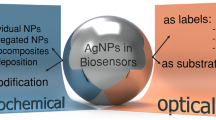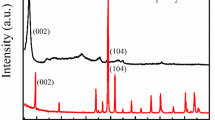Abstract
The authors describe a method for highly sensitive and selective determination of the activity of protein kinase (PKA). It is based on the finding that silver nanoclusters (AgNCs) can act as a nucleus to catalyze further deposition of silver nanoparticles. This causes the color of a solution to change from pale yellow to black. In the detection scheme presented here, the substrate peptide is phosphorylated by PKA in the presence of ATP. The resulting phosphopeptides bind to oligonucleotide-stabilized AgNCs in the presence of Zr(IV) ions due to electrostatic interactions between Zr(IV) and the phosphate groups, thereby capping the AgNCs. The silver enhancement process (leading to a color change to black) does not work if the AgNCs are capped. The degree of inhibition is proportional to the activity of the kinase. The color change can be detected visually or photographically in a microplate format by exploiting the changes in the grey values of the digital photos. In addition, the DNA-AgNCs display fluorescence emission at 635 nm when excited at 565 nm. Electrochemical assays were performed (at a working voltage as low as 38 mV vs. Ag/AgCl) by using a glassy carbon electrode modified with a solution containing AgNCs, Zr(IV) ions and the peptide, and immersing it into the silver enhancement solution. The assay is highly sensitive and selective. It was applied to the determination of PKA in lysates of HeLa cells. The detection limits typically are between 32 and 37 U⋅ L-1 based on a signal-to-noise ratio of 3.

A method for colorimetric and electrochemical determination of the activity of protein kinase activity is described that is based on silver nanocluster (AgNC) based signal amplification. AgNCs act as nucleus for further deposition of silver nanoparticles, but protein kinase can inhibit this process.






Similar content being viewed by others
References
Li T, Liu X, Liu D, Wang Z (2013) Sensitive detection of protein kinase a activity in cell lysates by peptide microarray-based assay. Anal Chem 85(15):7033–7037
Wang Z, Yan Z, Sun N, Liu Y (2015) Multiple signal amplification electrogenerated chemiluminescence biosensors for sensitive protein kinase activity analysis and inhibition. Biosens Bioelectron 68:771–776
Shen C, Li X, Rasooly A, Guo L, Zhang K, Yang M (2016) A single electrochemical biosensor for detecting the activity and inhibition of both protein kinase and alkaline phosphatase based on phosphate ions induced deposition of redox precipitates. Biosens Bioelectron 85:220–225
Wang L, Yang Y, Zhang C (2015) Phosphorylation-directed assembly of a single quantum dot based nanosensor for protein kinase assay. Anal Chem 87(9):4696–4703
Manning G, Whyte DB, Martinez R, Hunter T, Sudarsanam S (2002) The protein kinase complement of the human genome. Science 298:1912–1934
Andrew Futreal P, Kasprzyk A, Birney E, Mullikin JC, Wooster R, Stratton MR (2001) Cancer and genomics. Nature 409:850–852
Dancey J, Sausville EA (2003) Issues and progress with protein kinase inhibitors for cancer treatment. Nat Rev Drug Discov 2(4):296–313
Xu S, Liu Y, Wang T, Li J (2010) Highly sesnsitive electrogenerated chemiluminescence biosensor in profiling protein kinase activity and inhibition usingu gold nanoparticle as signal transduction probes. Anal Chem 82(22):9566–9572
Ji J, Yang H, Liu Y, Chen H, Kong J, Liu B (2009) TiO2-assisted silver enhanced biosensor for kinase activity profiling. Chem Commun 12:1508–1510
Xu X, Nie Z, Chen J, Fu Y, Li W, Shen Q, Yao S (2009) A DNA-based electrochemical strategy for label-free monitoring the activity and inhibition of protein kinase. Chem Commun 45:6946–6948
Wang Z, Sun N, He Y, Liu Y, Li J (2014) DNA assembled gold nanoparticles polymeric network blocks modular highly sensitive electrochemical biosensors for protein kinase activity analysis and inhibition. Anal Chem 86(12):6153–6159
Xu X, Liu X, Nie Z, Pan Y, Guo M, Yao S (2011) Label-free fluorescent detection of protein kinase activity based on the aggregation behavior of unmodified quantum dots. Anal Chem 83(1):52–59
Shen C, Xia X, Hu S, Yang M, Wang J (2015) Silver nanoclusters-based fluorescence assay of protein kinase activity and inhibition. Anal Chem 87(1):693–698
Liu X, Li Y, Xu X, Li P, Nie Z, Huang Y, Yao S (2014) Nanomaterial-based tools for protein kinase bioanalysis. Trends Anal Chem 58:40–53
Wei H, Chen C, Han B, Wang E (2008) Enzyme colorimetric assay using unmodified silver nanoparticles. Anal Chem 80:7051–7055
Ding L, Qian R, Xue Y, Cheng W, Ju H (2010) In situ scanometric assay of cell surface carbohydrate by glyconanoparticle-aggregation-regulated silver enhancement. Anal Chem 82:5804–5809
Zhou M, Yang M, Zhou F (2014) Paper based colorimetric biosensing platform utilizing cross-linked siloxane as probe. Biosens Bioelectron 55:39–43
Lin D, Wu J, Wang M, Yan F, Ju H (2012) Triple signal amplification of graphene film, polybead carried gold nanoparticles as tracing tag and silver deposition for ultrasensitive electrochemical immunosensing. Anal Chem 84(8):3662–3668
Lai G, Yan F, Wu J, Leng C, Ju H (2011) Ultrasensitive multiplexed immunoassay with electrochemical stripping analysis of silver nanoparticles catalytically deposited by gold nanoparticles and enzymatic reaction. Anal Chem 83(7):2726–2732
Dongwoo K, Weston LD, CA M (2009) Microarray-based multiplexed scanometric immunoassay for protein cancer markers using gold nanoparticle probes. Anal Chem 81:9183–9187
Guo Q, Li X, Shen C, Zhang S, Qi H, Li T, Yang M (2015) Electrochemical immunoassay for the protein biomarker mucin 1 and for MCF-7 cancer cells based on signal enhancement by silver nanoclusters. Microchim Acta 182(7–8):1483–1489
Monot J, Petit M, Lane SM, Guisle I, Léger J, Charles Tellier DRT, Bujoli B (2008) Towards zirconium phosphonate-based microarrays for probing DNA-protein interactions: critical influence of the location of the probe anchoring groups. J Am Chem Soc 130:6243–6251
Wang Y, Zhang L, Liang RP, Bai JM, Qiu JD (2013) Using graphene quantum dots as photoluminescent probes for protein kinase sensing. Anal Chem 85(19):9148–9155
Weerathunge P, Ramanathan R, Shukla R, Sharma TK, Bansal V (2014) Aptamer-controlled reversible inhibition of gold nanozyme activity for pesticide sensing. Anal Chem 86(24):11937–11941
Richards CI, Choi S, Hsiang J-C, Antoku Y, Vosch T, Bongiorno A, Tzeng Y-L (2008) Oligonucleotide-stabilized Ag nanocluster fluorophores. J Am Chem Soc 130:5038–5039
Gwinn EG, O'Neill P, Guerrero AJ, Bouwmeester D, Fygenson DK (2008) Sequence-dependent fluorescence of DNA-hosted silver nanoclusters. Adv Mater 20(2):279–283. doi:10.1002/adma.200702380
Zhang Y, Cai Y, Qi Z, Lu L, Qian Y (2013) DNA-templated silver nanoclusters for fluorescence turn-on assay of acetylcholinesterase activity. Anal Chem 85(17):8455–8461
Petty JT, Zheng J, Dickson RM (2004) DNA-templated Ag nanocluster formation. J Am Chem Soc 126(16):5207–5212
Oishi J, Asami Y, Mori T, Kang J-H, Tanabe M, Niidome T, Katayama Y (2007) Measurement of homogeneous kinase activity for cell lysates based on the aggregation of gold nanoparticles. ChemBioChem 8(8):875–879
Wang Z, Levy R, Fernig DG, Brust M (2006) Kinase-catalyzed modification of gold nanoparticles: a new approach to colorimetric kinase activity screening. J Am Chem Soc 128(7):2214–2215
Gupta S, Andresen H, Stevens MM (2011) Single-step kinase inhibitor screening using a peptide-modified gold nanoparticle platform. Chem Commun 47(8):2249–2251
Lee J-S, Lytton-Jean AKR, Hurst SJ, Mirkin CA (2007) Silver nanoparticle − oligonucleotide conjugates based on DNA with triple cyclic disulfide moieties. Nano Letters 7(7):2112–2115
Yin H, Wang M, Li B, Yang Z, Zhou Y, Ai S (2015) A sensitive electrochemical biosensor for detection of protein kinase a activity and inhibitors based on Phos-tag and enzymatic signal amplification. Biosens Bioelectron 63:26–32
Yin C, Wang M, Lei C, Wang Z, Li P, Li Y, Li W, Huang Y, Nie Z, Yao S (2015) Phosphorylation-mediated assembly of a semisynthetic fluorescent protein for label-free detection of protein kinase activity. Anal Chem 87(12):6311–6318
Acknowledgments
The authors thank the support of this work by the National Key Basic Research Program of China (2014CB744502), the National Natural Science Foundation of China (No. 21575165) and the Natural Science Foundation of Hunan province (No. 2015JJ1019).
Author information
Authors and Affiliations
Corresponding author
Ethics declarations
The author(s) declare that they have no competing interests.
Additional information
Congcong Shen and Kaina Zhang contributed equally to this work.
Electronic supplementary material
ESM 1
(DOC 4.07 mb)
Rights and permissions
About this article
Cite this article
Shen, C., Zhang, K., Gao, N. et al. Colorimetric and electrochemical determination of the activity of protein kinase based on retarded particle growth due to binding of phosphorylated peptides to DNA – capped silver nanoclusters. Microchim Acta 183, 2933–2939 (2016). https://doi.org/10.1007/s00604-016-1944-y
Received:
Accepted:
Published:
Issue Date:
DOI: https://doi.org/10.1007/s00604-016-1944-y




